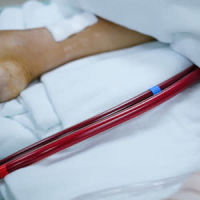Ventilator-associated pneumonia (VAP) is a major cause of morbidity and mortality in the ICU. It accounts for nearly 25% of infections in ICU patients. While there are guidelines to treat VAP, uncertainties remain when treating VAP due to Pseudomonas aeruginosa (PA-VAP), and the optimal duration of antibiotic therapy continues to be debated. In addition, there is limited evidence regarding the recurrence rate according to the duration of antibiotic therapy.
The Impact of the Duration of Antibiotics on clinical events in patients with Pseudomonas aeruginosa ventilator-associated pneumonia (iDIAPASON) study was conducted to evaluate the optimal duration of antibiotic therapy and determine the inferiority or non-inferiority of short antibiotic therapy (8 days) vs prolonged antibiotic therapy (15 days) in VAP due to PA.
One hundred and eight patients diagnosed with PA-VAP were randomly assigned to receive either 8 days or 15 days of antibiotic treatment. The choice of antibiotic therapy was left to the discretion of the physician based on their clinical assessment, previous antibiotic therapy, presence or absence of risk factors for multidrug-resistant (MDR) pathogen or hospitalisation in the previous 90 days, local epidemiological data, and knowledge that the patient is already colonised by an MDR pathogen.
The primary outcome of the study was a composite endpoint combining mortality and PA-VAP recurrence during the ICU stay until day 90. Secondary outcomes included duration of invasive mechanical ventilation, duration of ICU stay, antibiotic exposure duration, number and types of extrapulmonary infections, and acquisition of MDR pathogens.
Findings show that 25.5% of patients in the 15-day group reached the composite endpoint versus 35.2% in the 8-day group. Recurrence of PA-VAP during ICU stay was 9.2% in the 15-day group versus 17% in the 8-day group. Both groups had similar median days of mechanical ventilation, ICU stay, the number of extrapulmonary infections and acquisition of multidrug-resistant (MDR) pathogens during their stay in the ICU. The 90-day overall survival rate in the 15-day and 8-day groups was comparable.
Overall, these findings show that the short duration of antibiotic therapy has comparable clinical efficacy with the long duration of therapy for VAP due to PA. There was no significant difference between the 8-day and the 15-day strategy regarding mortality and PA-VAP recurrence during hospitalisation in the ICU within 90 days. It was, however, noted that patients in the 8-day group were twice as likely to have a PA-VAP recurrence compared to those in the 15-day group. Researchers did not find more multidrug-resistant pathogen acquisition in the 15-day group. The short-duration strategy was not associated with increased mortality, a longer duration of mechanical ventilation or length of ICU stay. There is thus a need for more research to reach any definitive conclusions about the best duration of antibiotic therapy for PA-VAP.
Source: Intensive Care Medicine
Image Credit: iStock
References:
Bouglé A, Tuffet S, Federici L et al. (2022) Comparison of 8 versus 15 days of antibiotic therapy for Pseudomonas aeruginosa ventilator-associated pneumonia in adults: a randomized, controlled, open-label trial. Intensive Care Med. https://doi.org/10.1007/s00134-022-06690-5
Latest Articles
VAP, Pseudomonas aeruginosa, antibiotic therapy
Long vs Short Duration Antibiotic Therapy for VAP
























